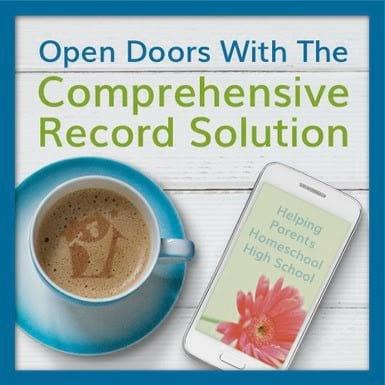
How to Submit Your Comprehensive Homeschool Records
Published on October 27, 2022 by LeeBinz
After all the blood, sweat, and tears of creating comprehensive homeschool records, and carefully documenting course descriptions, you have to submit them to colleges in order to reap the rewards. Here are free record keeping samples, so you can see what we are talking about. These detailed records can earn coveted admission spots and maximize college scholarships.
There are three ways to submit thorough homeschool records to colleges.
1. Upload to the Online Application Form
The Common Application Form. The Common App has a place for parents to act as the guidance counselor and upload transcripts. One of those should be the simple homeschool transcript. Another transcript you upload could be your complete comprehensive records including course descriptions. The maximum file size that can be uploaded is 2MB (2000 KB) and you can get clear instructions from their website.
Sometimes it’s necessary to divide your records into smaller chunks in order to meet the upload size limitation. You may need to divide the comprehensive records into two parts. Some parents will upload the transcript plus activity list and reading list into one document, and keep the course descriptions and work samples in the second document. Learn more about the Common App here: One Common Application – One Uncommonly Challenging Struggle.
Online Application Forms. Other online application forms may have a similar format, allowing for multiple descriptions to be uploaded as a “transcript.” Some colleges don’t have a specific uploading location. In that case, some parents will cut & paste information as necessary into different areas of the application form.
2. Email to the College Representative
When interacting with a college, it’s likely that a designated admission representative will be assigned to you. They may be assigned by geographical area, or they have a representative assigned to all homeschoolers. You can email the document to that person. When the time comes to do that, save your document as a PDF prior to emailing it, so that it can’t be changed.
Some technical types will send their documents digitally by email without using an attachment. They’ll use a drop box or an online cloud storage account to send those documents instead.
3. Mail Homeschool Records via Snail-Mail
This method has some advantages and disadvantages. It can be costly to print, bind, and mail a long document to multiple colleges. If your comprehensive records are long, it can cost up to $20 per college to print and snail-mail these documents.
There are benefits of mailing by snail-mail. It shows immediate recognition that you are one of “those” parents who are deeply invested in their child’s education. It also shows that your family is emotionally invested in the college, which is seen as demonstrated interest, which improves the chances of admission and scholarships for your child.
Course Descriptions Earn Scholarships
However you submit your records, just do it! Creating a comprehensive record is a lot of work. Submit them with the college application for the best chance of best results. Don’t wait until scholarship results are poor. Instead, make those records work for you, and submit them to colleges before they have made final decisions.
In my experience, homeschool course descriptions can make the difference in scholarships. Some colleges require course descriptions, and some will request course descriptions. Other colleges would rather not give scholarships, of course – they don’t want to create any impediments to paying full price! For this reason, sometimes colleges will say, “No, thank you.” to your comprehensive records. Send them anyway. Sometimes it’s smarter to ask for forgiveness than permission. Mail the records first, and ask forgiveness later, if needed.
A student’s high school record is the single most important factor in college admission decisions. The academic rigor of classes, and the grades a student gets, are even more important than SAT® or ACT® scores. Read, NACAC Survey: Grades Matter Most in College Admission. Studies show that the academic rigor of the high school curriculum is the single best predictor of success in college. Read U.S. Department of Education: The Toolbox Revisited.
So, how can you convince a college of your rigor? Homeschool course descriptions provide proof that your curriculum is, and has been, challenging. Course descriptions include details that show how your child succeeded with this challenging curriculum, and earned a solid GPA using rigorous material. This is why you create course descriptions.
When you need to create course descriptions, you may want to invest in the Comprehensive Record Solution. It includes everything you need from multiple training classes, to templates and descriptions you can cut and paste into your own course description packet. Help your student stand out from the crowd with Comprehensive Homeschool Records- the key to college admission and scholarships.
Thank you, Lee! You helped me tremendously complete transcripts, and especially, course descriptions. Your eBooks are fantastic and have helped me for years! I especially love that you empower us to capture the learning going on in our homes without changing the way we each homeschool!! I have one daughter attending a private college and another has just received three college acceptances with Presidential Scholarships! We are very excited!! NY universities are not always accepting of homeschool transcripts, because of the state laws. With the course descriptions you helped me create, we had no issues.
All the best to you,
Tanya in CT







